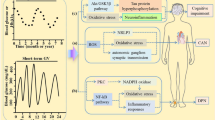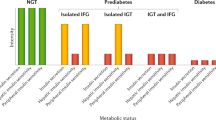Abstract
Stroke and peripheral neuropathy are recognized neurological complications of diabetes. Increasing epidemiological evidence also implicates the prediabetic state of impaired glucose tolerance (IGT) as a risk factor for cerebrovascular events and peripheral neuropathy. Data linking IGT to cognitive decline or deficits, however, are less robust. IGT is one component of metabolic syndrome, together with central obesity, hypertension, hypertriglyceridemia and reduced HDL. Each component of metabolic syndrome is an independent risk factor for stroke, but hyperglycemia might be more important than other components in the pathogenesis of neuropathy. Goal-driven diet and exercise regimens, together with pharmacological treatment of hyperlipidemia and hypertension, reduce stroke risk, but the effect of these interventions on neuropathy has not been fully explored.
Key Points
-
The American Diabetes Association defines prediabetes as either impaired fasting glucose or impaired glucose tolerance (IGT)
-
Hyperglycemia, along with central obesity, hypertension, increased triglycerides and reduced HDL cholesterol, comprise the metabolic syndrome
-
Patients discovered to have IGT or impaired fasting glucose should receive prompt and intensive treatment to normalize blood glucose and treat other features of metabolic syndrome
-
An association between prediabetes and neuropathy has been established through several epidemiological lines of evidence
-
Compared with age-matched normoglycemic controls, patients with IGT are at a greater risk of death from all causes; most of this excess mortality can be attributed to consequences of macrovascular disease
-
Cross-sectional and longitudinal studies have convincingly demonstrated an association between diabetes and dementia, but evidence for a link between cognitive defects and IGT has been mixed
-
Further studies are needed to examine the direct metabolic effects of hyperglycemia, insulin resistance and hyperinsulinemia on peripheral nerves and the brain
This is a preview of subscription content, access via your institution
Access options
Subscribe to this journal
Receive 12 print issues and online access
$209.00 per year
only $17.42 per issue
Buy this article
- Purchase on Springer Link
- Instant access to full article PDF
Prices may be subject to local taxes which are calculated during checkout
Similar content being viewed by others
References
Expert Committee on the Diagnosis and Classification of Diabetes Mellitus (2003) Report of the Expert Committee on the Diagnosis and Classification of Diabetes Mellitus. Diabetes Care 26 (Suppl 1): S5–S20
Isomaa B et al. (2001) Cardiovascular morbidity and mortality associated with the metabolic syndrome. Diabetes Care 24: 683–689
Singleton JR et al. (2003) Microvascular complications of impaired glucose tolerance. Diabetes 52: 2867–2873
Brownlee M (2001) Biochemistry and molecular cell biology of diabetic complications. Nature 414: 813–820
King RHM (2001) The role of glycation in the pathogenesis of diabetic polyneuropathy. J Clin Pathol Mol Pathol 54: 400–408
Kahn R et al. (2005) The metabolic syndrome: time for a critical appraisal: joint statement from the American Diabetes Association and the European Association for the Study of Diabetes. Diabetes Care 28: 2289–2304
Harris MI et al. (1998) Prevalence of diabetes, impaired fasting glucose, and impaired glucose tolerance in U.S. adults: the third National Health and Nutrition Examination Survey, 1988–1994. Diabetes Care 21: 518–524
Diabetes Prevention Program Research Group (2002) Reduction in the incidence of type 2 diabetes with lifestyle intervention or metformin. New Eng J Med 346: 393–403
Tuomilehto J et al. (2001) Prevention of type 2 diabetes mellitus by changes in lifestyle among subjects with impaired glucose tolerance. N Engl J Med 344: 1343–1350
Lehtinen JM et al. (1989) Prevalence of neuropathy in newly diagnosed NIDDM and nondiabetic control subjects. Diabetes 38: 1308–1313
Franklin GM et al. (1990) Sensory neuropathy in non-insulin-dependent diabetes mellitus: the San Luis Valley Diabetes Study. Am J Epidemiol 131: 633–643
Fujimoto WY et al. (1994) Diabetes and diabetes risk factors in second and third-generation Japanese Americans in Seattle. Diabetes Res Clin Pract 24: S43–S52
Eriksson KF et al. (1994) Diabetes mellitus but not impaired glucose tolerance is associated with dysfunction in peripheral nerves. Diab Med 11: 279–285
Singleton JR et al. (2001) Increased prevalence of impaired glucose tolerance in patients with painful sensory neuropathy. Diabetes Care 24: 1448–1453
Sumner CJ et al. (2003) The spectrum of neuropathy in diabetes and impaired glucose tolerance. Neurology 60: 108–111
Hughes RA et al. (2004) A controlled investigation of the cause of chronic idiopathic axonal polyneuropathy. Brain 127: 1723–1730
Singleton JR et al. (2001) Painful sensory neuropathy associated with impaired glucose tolerance. Muscle Nerve 24: 1225–1228
Smith AG et al. (2001) Skin biopsy findings in patients with neuropathy associated with diabetes and impaired glucose tolerance. Neurology 57: 1701–1704
Thomas PK (1997) Classification, differential diagnosis, and staging of diabetic peripheral neuropathy. Diabetes 46 (Suppl 2): S54–S57
Annuzzi G et al. (1983) The relationship between blood glucose concentration and beat-to-beat variation in asymptomatic subjects. Acta Diabetol Lat 20: 57–62
Smith AG et al. (2005) Electrophysiologic features of impaired glucose tolerance neuropathy [abstract]. Muscle Nerve 32: 390
Kelkar P and Hammer-White S (2005) Impaired glucose tolerance in nondiabetic lumbosacral radiculoplexus neuropathy. Muscle Nerve 31: 273–274
Smith AG and Singleton JR (2004) The diagnostic yield of a standardized approach to idiopathic sensory-predominant neuropathy. Arch Intern Med 164: 1021–1025
Herrmann D et al. (1999) Epidermal nerve fiber density: association with sural nerve morphometry and electrophysiology in peripheral neuropathies. Neurology 52: A309–A310
Periquet MI et al. (1999) Painful sensory neuropathy: prospective evaluation using skin biopsy. Neurology 53: 1641–1647
Freeman R et al. (2003) Quantitative sensory testing cannot differentiate simulated sensory loss from sensory neuropathy. Neurology 60: 465–470
Smith S et al. (2005) The efficacy of a practical diet and exercise counseling regimen on metabolic parameters and neuropathy progression in patients with impaired glucose tolerance and neuropathy [abstract]. Neurology 64 (Suppl 1): A375
Singleton JR et al. (2005) Polyneuropathy with impaired glucose tolerance: implications for diagnosis and therapy. Curr Treat Options Neurol 7: 33–42
The DECODE Study Group for the European Diabetes Epidemiology Group (2001) Glucose tolerance and cardiovascular mortality: comparison of fasting and two hour diagnostic criteria. Arch Intern Med 161: 397–405
Beks PH et al. (1997) Carotid artery stenosis is related to blood glucose level in an elderly Caucasian population: the Hoorn Study. Diabetologia 40: 290–298
Bonora E et al. (2000) Impaired glucose tolerance, type II diabetes mellitus and carotid atherosclerosis: prospective results from the Bruneck Study. Diabetologia 42: 156–164
Kernan WN et al. (2005) Prevalence of abnormal glucose tolerance following a transient ischemic attack or ischemic stroke. Arch Intern Med 165: 227–233
Stratton IM et al. (2000) Association of glycaemia with macrovascular and microvascular complications of type 2 diabetes (UKPDS 35): prospective observational study. BMJ 321: 405–412
Bonora E and Muggeo M (2001) Postprandial blood glucose as a risk factor for cardiovascular disease in Type II diabetes: the epidemiological evidence. Diabetologia 44: 2107–2114
The DECODE Study Group on behalf of the European Diabetes Epidemiology Group (1999) Glucose tolerance and mortality: comparison of WHO and American Diabetes Association diagnostic criteria. Lancet 354: 617–621
Diabetes Control and Complications Research Group (1993) The effect of intensive treatment of diabetes on the development and progression of long-term complications in insulin-dependent diabetes mellitus. New Engl J Med 329: 977–986
UK Prospective Diabetes Study Group (1998) Tight blood pressure control and risk of macrovascular and microvascular complications in type 2 diabetes: UKPDS 38. BMJ 317: 703–713
Ratner R et al. (2005) Impact of intensive lifestyle and metformin therapy on cardiovascular disease risk factors in the diabetes prevention program. Diabetes Care 28: 888–894
Xu WL et al. (2004) Diabetes mellitus and risk of dementia in the Kungsholmen project: a 6-year follow-up study. Neurology 63: 1181–1186
Curb JD et al. (1999) Longitudinal association of vascular and Alzheimer's dementias, diabetes, and glucose tolerance. Neurology 52: 971–975
Kalmijn S et al. (1995) Glucose intolerance, hyperinsulinaemia and cognitive function in a general population of elderly men. Diabetologia 38: 1096–1102
Hiltunen LA et al. (2001) Glucose tolerance and cognitive impairment in an elderly population. Public Health 115: 197–200
Kuusisto J et al. (1993) Essential hypertension and cognitive function: the role of hyperinsulinemia. Hypertension 22: 771–779
Convit A et al. (2003) Reduced glucose tolerance is associated with poor memory performance and hippocampal atrophy among normal elderly. Proc Natl Acad Sci USA 100: 2019–2022
Lindeman RD et al. (2001) A biethnic community survey of cognition in participants with type 2 diabetes, impaired glucose tolerance, and normal glucose tolerance: the New Mexico Elder Health Survey. Diabetes Care 24: 1567–1572
Kanaya AM et al. (2004) Change in cognitive function by glucose tolerance status in older adults: a 4-year prospective study of the Rancho Bernardo study cohort. Arch Intern Med 164: 1327–1333
Awad N et al. (2004) The relationship between impaired glucose tolerance, type 2 diabetes, and cognitive function. J Clin Exp Neuropsychol 26: 1044–1080
Kilander L et al. (1998) Hypertension is related to cognitive impairment: a 20-year follow-up of 999 men. Hypertension 31: 780–786
Pavlik VN et al. (2005) Cardiovascular risk factors and cognitive function in adults 30–59 years of age (NHANES III). Neuroepidemiology 24: 42–50
Expert Panel on Detection, Evaluation and Treatment of High Blood Cholesterol in Adults (2001) Executive summary of the third report of the National Cholesterol Education Program (NCEP) Expert Panel on Detection, Evaluation and Treatment of High Blood Cholesterol in Adults (Adult Treatment Panel III). JAMA 285: 2486–2497
World Health Organization (1999) Definition, Diagnosis and Classification of Diabetes Mellitus and its Complications: Report of a WHO Consultation. Geneva: World Health Organization
Acknowledgements
JR Singleton and AG Smith are supported in part by NIH NS40458, NIH DK064814 and NIH-NCRR M01 RR 00064. The authors acknowledge the many investigators whose work could not be cited owing to a limit on the number of references.
Author information
Authors and Affiliations
Corresponding author
Ethics declarations
Competing interests
The authors declare no competing financial interests.
Rights and permissions
About this article
Cite this article
Singleton, J., Smith, A. Therapy Insight: neurological complications of prediabetes. Nat Rev Neurol 2, 276–282 (2006). https://doi.org/10.1038/ncpneuro0172
Received:
Accepted:
Issue Date:
DOI: https://doi.org/10.1038/ncpneuro0172



